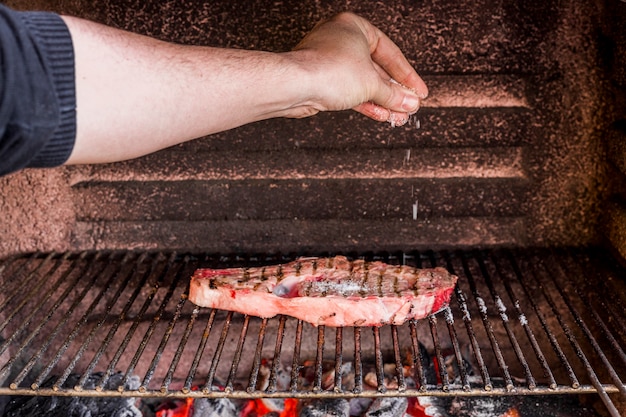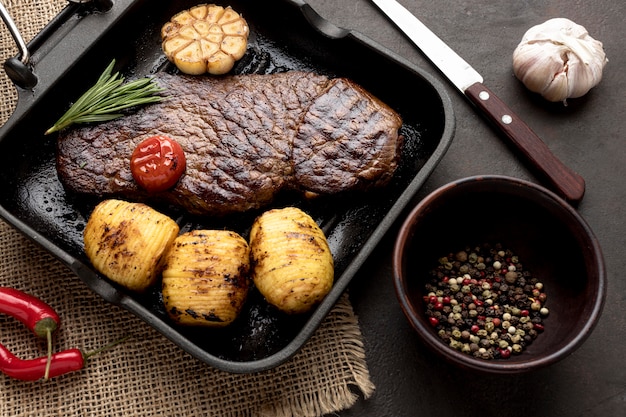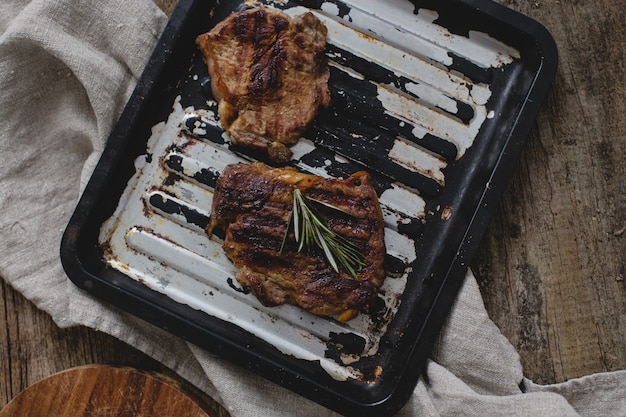As a seasoned home cook, I've spent countless hours in the kitchen experimenting with different cooking techniques, especially when it comes to steak. There’s nothing quite like a perfectly cooked steak, juicy and tender, bursting with flavour. And while I love the sizzle and theatre of grilling, there’s a certain elegance to oven-baking that I find truly satisfying. It’s a method that allows for greater control over the cooking process, ensuring a consistently delicious result, every single time. So, let me share my tried and tested secrets for achieving that perfect oven-baked steak, from the humble ribeye to the luxurious wagyu.
(Part 1) Selecting Your Steak

The Cut Matters
Let's face it, the quality of your steak is paramount. A good cut makes all the difference, and my go-to choices are ribeye, sirloin, and new york strip. Ribeye, with its marbling and tenderness, delivers rich flavour and juicy results. Its generous amount of fat, distributed throughout the muscle, renders beautifully during cooking, adding a luscious richness to every bite. Sirloin, slightly leaner, offers a slightly firmer texture, perfect for those who prefer a more substantial chew. The New York strip, well, it’s a classic for a reason. Its balanced flavour and good marbling make it a versatile choice, suitable for both casual weeknight dinners and special occasion meals.
Thickness is Key
Don't be tempted by thin cuts - they'll cook too quickly and dry out. A good steak should be at least 1.5 inches thick, allowing for a juicy, pink centre. If you're after a more intense flavour and a slightly crispier exterior, consider opting for a thicker cut, like a 2-inch porterhouse. The extra thickness allows for a more pronounced sear and a greater contrast between the tender, juicy interior and the crispy, flavourful exterior. This is where the magic of oven-baking truly shines - it allows for precise control over the cooking process, resulting in a steak that's both visually appealing and incredibly delicious.
The Butcher's Touch
If you're lucky enough to have a local butcher, ask for their advice. They can guide you to the best cuts available and even help you choose a steak that’s perfectly suited to your preferences and the oven-baking method. Don’t hesitate to ask about their recommendations; a good butcher will be a goldmine of culinary wisdom. They’ll often have a great understanding of the different cuts, their marbling, and how best to cook them. They can also give you valuable tips on how to choose the perfect steak for your needs, whether you're looking for something tender and juicy, or leaner and more robust.
(Part 2) Prepping for Perfection

Room Temperature for a Reason
One of the most crucial steps is bringing your steak to room temperature before cooking. This might seem counterintuitive, but allowing the steak to warm up ensures even cooking and prevents the inside from remaining cold while the outside cooks too quickly. Think of it this way: a cold steak will take longer to cook evenly, potentially leading to a tough, dry exterior while the inside remains undercooked. By bringing it to room temperature, you’re allowing the heat to penetrate the steak more consistently, leading to a perfectly cooked result. Typically, I'll take my steak out of the fridge about an hour before cooking. This gives it enough time to come up to room temperature while I’m preparing the rest of the meal. It's a simple step, but it makes a significant difference in the final product.
Seasoning with Savvy
Salt and pepper are the backbone of any good steak seasoning, but don’t be afraid to experiment with other flavours. I often add a pinch of garlic powder and onion powder to my seasoning blend, creating a depth of flavour that truly elevates the steak. The warmth of the garlic and onion complements the richness of the steak, adding a subtle complexity that enhances the overall flavour profile. You can also try other spices like smoked paprika, oregano, or even a touch of cayenne pepper if you like a kick. Smoked paprika adds a smoky depth, oregano brings a herbaceous note, and cayenne pepper provides a subtle heat, allowing you to tailor the flavour to your preferences. Just remember, less is more when it comes to seasoning. A little bit goes a long way, so start with a light hand and adjust to taste.
Don’t Forget the Fat
The fat on a steak is not just for flavour - it's essential for rendering and creating a delicious crust. Don't trim it off! Before seasoning, I like to gently brush the fat with olive oil, helping it to render evenly and provide a nice, crispy texture. The fat, as it melts and renders, bastes the steak, adding moisture and flavour. The oil helps to create a beautiful, golden-brown crust, intensifying the flavours and providing a satisfyingly crunchy texture. Remember, the key is to be gentle while brushing the oil. You don't want to press the fat down or risk pushing it off the steak. A light, even coat is all you need.
(Part 3) The Oven-Baking Magic

The Heat is On
The perfect oven temperature for a steak depends on your preferred level of doneness. For medium-rare, I usually bake at 400°F (200°C). This temperature is hot enough to create a beautiful sear on the outside while keeping the inside juicy. If you prefer a more well-done steak, you can increase the temperature to 425°F (220°C). Just remember to adjust the cooking time accordingly. The higher temperature will result in a more intense sear, while the longer cooking time will ensure the steak is cooked through to your desired level. The key is to find the right balance between heat and time to achieve the perfect result.
Baking Time: A Guide
The baking time depends on the thickness of your steak and your desired level of doneness. A good rule of thumb is about 10-12 minutes per side for a 1.5-inch steak. Always check the internal temperature with a meat thermometer, though. The ideal temperature for medium-rare is 130-135°F (54-57°C), while medium is 140-145°F (60-63°C). Remember, your oven's temperature can vary, so keep a close eye on the cooking process. Don’t be afraid to check it a few minutes early to ensure you don't overcook it. Overcooking a steak can result in a dry, tough, and flavourless piece of meat, so it's important to monitor the cooking process closely.
Resting is Key
Once your steak is cooked to your liking, remove it from the oven and let it rest for at least 5-10 minutes before slicing. This allows the juices to redistribute throughout the steak, resulting in a more tender and flavourful cut. The resting process is crucial because as the steak cooks, the juices are pushed to the centre. When you slice into a hot steak immediately, those juices will run out, leaving you with a dry and less flavourful piece of meat. By resting the steak, you allow those juices to redistribute, resulting in a more tender and flavourful steak. Resting is truly an essential step in the oven-baking process.
(Part 4) Searing for that Perfect Crust
For that incredible sear, I prefer a cast iron skillet. It heats up quickly and distributes heat evenly, creating the ideal environment for achieving a beautiful, crispy crust. Place the skillet on the stovetop over high heat. Once it's screaming hot, add the steak and sear each side for about 2-3 minutes. This creates a beautiful crust, locking in the moisture and intensifying the flavour. Make sure to use tongs to carefully flip the steak, minimizing the chance of sticking and ensuring even browning. The intense heat of the cast iron skillet creates a Maillard reaction, a chemical reaction that browns the surface of the steak and creates a complex array of flavours. This creates the signature crispy, flavourful crust that makes a steak truly irresistible.
(Part 5) Elevating Your Oven-Baked Steak
The Art of Glazing
A simple glaze can elevate your oven-baked steak to the next level. For a classic flavour, I often brush a mixture of butter, honey, and soy sauce onto the steak during the last few minutes of cooking. This creates a sticky, caramelised glaze that adds a touch of sweetness and umami. The butter adds richness and moisture, the honey provides a sweet counterpoint to the savoury flavours, and the soy sauce adds depth and complexity. You can also experiment with other glazes, like a red wine reduction or a Dijon mustard glaze, depending on your taste. A red wine reduction adds a sophisticated, earthy note, while a Dijon mustard glaze provides a tangy and slightly spicy kick. The possibilities are endless, allowing you to create your own signature glaze to perfectly complement your steak.
Herbs for a Burst of Freshness
A sprinkle of fresh herbs like rosemary, thyme, or parsley just before serving adds a wonderful burst of flavour and freshness. I like to chop the herbs finely and scatter them over the steak, or you can even create a simple herb butter by blending softened butter with your favourite herbs and a pinch of salt and pepper. Rosemary adds a fragrant, earthy note, thyme brings a warm, slightly lemony flavour, and parsley provides a bright, herbaceous taste. The herbs create a refreshing contrast to the rich, savoury flavours of the steak, making for a truly balanced and satisfying culinary experience.
The Sidekick to Your Steak
No steak is complete without a delicious accompaniment. My personal favourite is a simple side of roasted vegetables. I love the combination of sweet and savoury flavours, and the roasting process brings out the best in vegetables like broccoli, carrots, and potatoes. The roasting process caramelizes the vegetables, creating a depth of flavour that complements the steak perfectly. For a lighter option, a green salad tossed with a vinaigrette is a perfect complement to the rich flavours of the steak. The crisp, refreshing salad balances the richness of the steak, providing a lighter and more balanced meal.
(Part 6) Mastering the Internal Temperature
Meat Thermometer: Your Best Friend
Don't rely solely on visual cues for doneness - always use a meat thermometer to ensure your steak is cooked to your liking. It’s the most accurate way to ensure you’re not overcooking or undercooking your steak. The tip of the thermometer should be inserted into the thickest part of the steak, avoiding any bones or fat. A meat thermometer eliminates the guesswork, ensuring that your steak is cooked to your precise specifications. It’s a simple tool that can make a big difference in the quality of your steak.
Doneness Guide: A Visual Aid
Here's a simple guide to help you understand the different levels of doneness:
| Doneness | Internal Temperature (°F) | Description |
|---|---|---|
| Rare | 125-130 | Cool red center, slightly warm to the touch |
| Medium-Rare | 130-135 | Warm red center, slightly firm |
| Medium | 140-145 | Pink center, firm |
| Medium-Well | 150-155 | Slight pink, almost grey center, firm |
| Well-Done | 160 | Grey center, very firm |
(Part 7) Tips and Tricks
steak storage
Always store your steak in the coldest part of your fridge, wrapped tightly in plastic wrap or sealed in a freezer bag. This prevents moisture loss and helps to keep the steak fresh. If you want to freeze your steak for later use, make sure to wrap it well in plastic wrap and then place it in a freezer bag to prevent freezer burn. Thaw it slowly in the refrigerator before cooking. Freezing and thawing can affect the texture of the steak, so it’s best to thaw it slowly in the refrigerator. This allows the steak to thaw evenly and prevents ice crystals from forming, which can damage the muscle fibers and make the steak tough.
The Power of Rest
Resting your steak after cooking is crucial for tenderness and flavour. It allows the juices to redistribute throughout the steak, preventing them from running out when you slice it. Cover the steak loosely with foil and allow it to rest for at least 5-10 minutes before slicing and serving. This simple step will make a world of difference in the final result. Resting also helps the steak to relax, making it easier to slice and resulting in more evenly distributed juices throughout the cut.
Don't Overcook!
One of the biggest mistakes people make is overcooking their steak. Overcooked steak is dry, tough, and loses its flavour. If you’re unsure about the doneness, err on the side of undercooking. You can always cook it a little longer if needed, but you can't undo overcooking. A perfectly cooked steak should have a slight give when pressed, and the centre should be juicy and pink. Overcooking will result in a grey, dry, and tough steak, so it's important to pay attention to the cooking time and use a meat thermometer to ensure that your steak is cooked to your liking.
(Part 8) FAQs
Can I use any type of oven for baking a steak?
Yes, you can use any type of oven, whether it’s a conventional oven, a fan oven, or even an air fryer. Just be sure to adjust the temperature and cooking time accordingly. For an air fryer, you'll likely need to cook the steak for a shorter time at a slightly lower temperature. Air fryers work by circulating hot air, which creates a similar effect to baking in an oven. However, they tend to cook food more quickly, so you'll need to adjust the cooking time and temperature accordingly.
What should I do if my steak is too thick for the oven?
If your steak is too thick to fit comfortably in your oven, you can try using a grill pan or a large cast iron skillet. Just make sure to preheat it well and use a meat thermometer to check the internal temperature. A grill pan or a cast iron skillet will distribute heat more evenly, allowing the steak to cook evenly and achieve a beautiful sear. Make sure to preheat the pan thoroughly before adding the steak to ensure that it cooks evenly and achieves a nice crust.
What are some other flavour combinations I can try for my steak?
The possibilities are endless! You can try using herbs like rosemary, thyme, oregano, garlic, and onion. Experiment with spices like smoked paprika, chili powder, cayenne pepper, or even a dash of cumin. For a sweeter glaze, try honey, maple syrup, or a balsamic reduction. You can also try incorporating citrus zest, such as lemon or orange, or even a touch of mustard for a tangy kick. Don't be afraid to experiment and find the flavours that best suit your taste.
Can I bake more than one steak at a time?
Absolutely! Just make sure to leave enough space between the steaks to allow for even cooking. You may need to adjust the cooking time slightly depending on the number of steaks you're baking. Use a meat thermometer to ensure each steak is cooked to your liking. The key is to make sure that the steaks are not touching each other, allowing for even heat distribution and ensuring that all of the steaks are cooked to the same level of doneness. You may need to increase the cooking time slightly, especially if you're baking a larger number of steaks.
What is the best way to reheat leftover steak?
The best way to reheat leftover steak is to use a pan over medium heat. Add a tablespoon or two of butter and heat until melted. Add the steak and cook for 2-3 minutes per side, or until heated through. You can also use a microwave, but it's not as ideal as pan-frying as it can make the steak dry and tough. The pan-frying method allows you to reheat the steak evenly without drying it out. Adding a bit of butter helps to keep the steak moist and adds a rich, buttery flavour. If you're using a microwave, try to use a low setting and cover the steak with a damp paper towel to prevent it from drying out.
Everyone is watching

Corn on the Cob: The Ultimate Guide to Perfectly Cooked Ears
Healthy MealsAh, corn on the cob. Just the name evokes images of sunny days, barbecues, and that sweet, juicy flavour that ...

Perfect Pork Roast Oven Cooking Time: A Guide to Delicious Results
Healthy MealsThere's something truly satisfying about a perfectly roasted pork. The aroma alone is enough to make your mout...

Ham Cooking Time: How Long to Bake, Smoke, or Boil a Delicious Ham
Healthy MealsAh, ham. It's a classic, isn't it? A real crowd-pleaser, especially around holidays. And when done right, it'...

Scallops: The Ultimate Guide to Perfect Cooking
Healthy MealsAh, scallops. Those delicate, sweet, and utterly delicious morsels of the sea. They hold a special place in my...

Spaghetti Squash: The Ultimate Guide to Cooking and Serving
Healthy MealsRemember that time you saw spaghetti squash at the supermarket, looking all bumpy and strange, and thought, "W...
